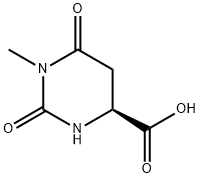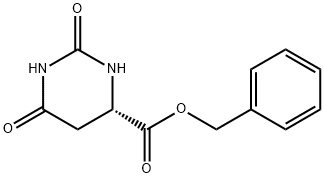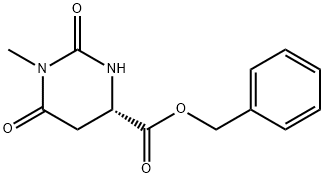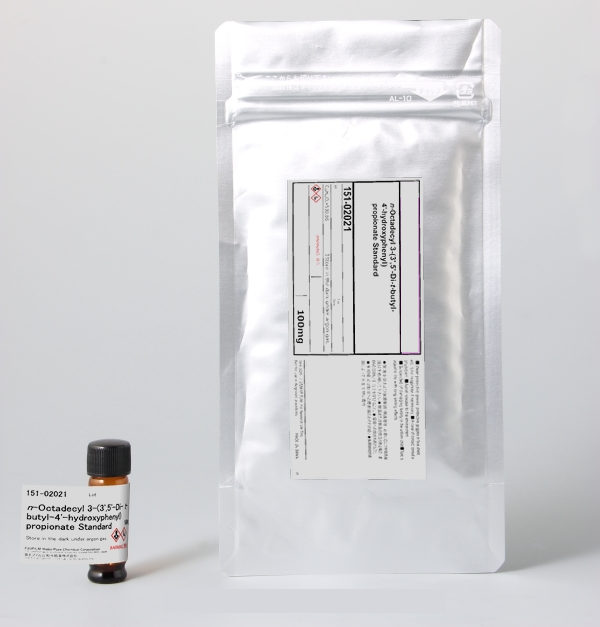L-DIHYDROOROTIC ACID
Synonym(s):L -Hydroorotic acid;2,6-Dioxohexahydro-4-pyrimidinecarboxylic acid;Dihydro-L -orotic acid
- CAS NO.:5988-19-2
- Empirical Formula: C5H6N2O4
- Molecular Weight: 158.11
- MDL number: MFCD00085339
- EINECS: 624-952-7
- SAFETY DATA SHEET (SDS)
- Update Date: 2025-07-04 15:10:32

What is L-DIHYDROOROTIC ACID?
Chemical properties
White to off-white crystalline powder
The Uses of L-DIHYDROOROTIC ACID
L-Dihydroorotic acid a metabolite.
What are the applications of Application
L-Dihydroorotic acid is a metabolite
Definition
ChEBI: (S)-dihydroorotic acid is the (S)-enantiomer of dihydroorotic acid that is an intermediate in the metabolism of pyridine. It has a role as a Saccharomyces cerevisiae metabolite, a human metabolite, an Escherichia coli metabolite and a mouse metabolite. It is a conjugate acid of a (S)-dihydroorotate. It is an enantiomer of a (R)-dihydroorotic acid.
Biochem/physiol Actions
L-Dihydroorotic acid (DHO) serves as a substrate for dihydroorotate dehydrogenase (DHODH), an enzyme in the de novo synthesis of pyrimidine. Inhibition of DHOH by its inhibitors causes a large accumulation of upstream metabolite DHO and a reduction in the uridine levels. Therefore, DHO and uridine can be used as biomarkers for pyrimidine synthesis for the clinical development of DHOH inhibitors.
Properties of L-DIHYDROOROTIC ACID
| Melting point: | 254-255 °C (dec.)(lit.) |
| Boiling point: | 283.16°C (rough estimate) |
| Density | 1.523 |
| refractive index | 1.5090 (estimate) |
| storage temp. | Sealed in dry,2-8°C |
| solubility | DMSO (Slightly), Water (Slightly, Heated, Sonicated) |
| form | Powder |
| pka | 2.82±0.20(Predicted) |
| color | White to off-white |
| Water Solubility | Soluble in water (partly), and dimethyl formamide. |
| CAS DataBase Reference | 5988-19-2(CAS DataBase Reference) |
| NIST Chemistry Reference | Orotic acid, dihydro-, l-(5988-19-2) |
Safety information for L-DIHYDROOROTIC ACID
| Signal word | Warning |
| Pictogram(s) |
 Exclamation Mark Irritant GHS07 |
| GHS Hazard Statements |
H315:Skin corrosion/irritation H319:Serious eye damage/eye irritation H335:Specific target organ toxicity, single exposure;Respiratory tract irritation |
| Precautionary Statement Codes |
P302+P352:IF ON SKIN: wash with plenty of soap and water. P305+P351+P338:IF IN EYES: Rinse cautiously with water for several minutes. Remove contact lenses, if present and easy to do. Continuerinsing. |
Computed Descriptors for L-DIHYDROOROTIC ACID
| InChIKey | UFIVEPVSAGBUSI-REOHCLBHSA-N |
New Products
Indole Methyl Resin tert-butyl 9-methoxy-3-azaspiro[5.5]undecane-3-carboxylate Boc-His(Boc)-OH 2-CTC Resin 4-Chloro-7-tosy1-7Hpyrrolo[2,3-d]pyrimidine 5,7-Dibromo-1H-indole 2,5-dichloro-N-hydroxy-4,6-dimethylpyridine-3-carboximidamide 2,2-Dimethoxy-7-azaspiro[3.5]nonane hydrochloride 4-chloromethyl-5-methyl-1,3-dioxol-2-one (DMDO-Cl) R-2-BENZYLOXY PROPIONIC ACID 1,1’-CARBONYLDIIMIDAZOLE 1,1’-CARBONYLDI (1,2-4 TRIAZOLE) N-METHYL INDAZOLE-3-CARBOXYLIC ACID 4-((2-hydroxyethyl)thio)benzoic acid 1-(TERT-BUTOXYCARBONYL)-2-PYRROLIDINONE Methyl 6-methylnicotinate 3-Pyridineacrylic acid tert-Butyl carbazate TETRAHYDRO-2H-PYRAN-3-OL 2-((4-morpholinophenylamino) (methylthio) methylene) malononitrile 3-(4-morpholinophenylamino)-5-amino-1H-pyrazole-4-carbonitrile 2,4-dihydroxybenzaldehyde 1,3-Diethyl-1,3-Diphenylurea Methyl 2-methylquinoline-6-carboxylateRelated products of tetrahydrofuran
![L-4,5-DIHYDROOROTIC ACID, [2-14C]-](https://img.chemicalbook.in/StructureFile/ChemBookStructure4/GIF/CB3767465.gif)






![DIHYDROOROTIC ACID, [5,6-3H]](https://img.chemicalbook.in/StructureFile/ChemBookStructure3/GIF/CB5120691.gif)
You may like
-
 L-Dihydroorotic acid 98% (HPLC) CAS 5988-19-2View Details
L-Dihydroorotic acid 98% (HPLC) CAS 5988-19-2View Details
5988-19-2 -
 L-Dihydroorotic acid CAS 5988-19-2View Details
L-Dihydroorotic acid CAS 5988-19-2View Details
5988-19-2 -
 Pyridine 99.5% HPLC /UV SpectroscopyView Details
Pyridine 99.5% HPLC /UV SpectroscopyView Details
110-86-1 -
 Piperazine Spot supply, best priceView Details
Piperazine Spot supply, best priceView Details
110-85-0 -
 Dibutyl PhthalateView Details
Dibutyl PhthalateView Details
84-74-2 -
 Imidazole Spot supply, competitive priceView Details
Imidazole Spot supply, competitive priceView Details
288-32-4 -
 Octadecyl 3-(3,5-di-tert-butyl-4-hydroxyphenyl)propionate 98% (GC)View Details
Octadecyl 3-(3,5-di-tert-butyl-4-hydroxyphenyl)propionate 98% (GC)View Details
2082-79-3 -
 Thiourea 99% ARView Details
Thiourea 99% ARView Details
62-56-6
